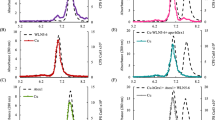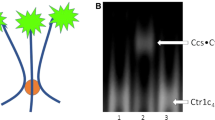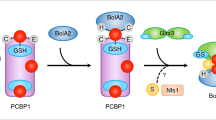Abstract
Copper is both an essential element as a catalytic cofactor and a toxic element because of its redox properties. Once in the cell, Cu(I) binds to glutathione (GSH) and various thiol-rich proteins that sequester and/or exchange copper with other intracellular components. Among them, the Cu(I) chaperone Atx1 is known to deliver Cu(I) to Ccc2, the Golgi Cu–ATPase, in yeast. However, the mechanism for Cu(I) incorporation into Atx1 has not yet been unraveled. We investigated here a possible role of GSH in Cu(I) binding to Atx1. Yeast Atx1 was expressed in Escherichia coli and purified to study its ability to bind Cu(I). We found that with an excess of GSH [at least two GSH/Cu(I)], Atx1 formed a Cu(I)-bridged dimer of high affinity for Cu(I), containing two Cu(I) and two GSH, whereas no dimer was observed in the absence of GSH. The stability constants (log β) of the Cu(I) complexes measured at pH 6 were 15–16 and 49–50 for CuAtx1 and Cu I2 (GS−)2(Atx1)2, respectively. Hence, these results suggest that in vivo the high GSH concentration favors Atx1 dimerization and that Cu I2 (GS−)2(Atx1)2 is the major conformation of Atx1 in the cytosol.









Similar content being viewed by others
Abbreviations
- BCA:
-
Bicinchoninic acid
- BCS:
-
Bathocuproine disulfonate
- DTNB:
-
5,5′-Dithiobis(2-nitrobenzoate)
- DTT:
-
Dithiothreitol
- EPR:
-
Electron paramagnetic resonance
- GSH:
-
Glutathione
- Mops:
-
3-(N-Morpholino)propanesulfonic acid
- PAGE:
-
Polyacrylamide gel electrophoresis
- SDS:
-
Sodium dodecyl sulfate
- TCEP:
-
Tris(2-carboxyethyl)phosphine hydrochloride
- TTM:
-
Tetrathiomolybdate
References
Jensen LT, Howard WR, Strain JJ, Winge DR, Culotta VC (1996) J Biol Chem 271:18514–18519
Calderone V, Dolderer B, Hartmann HJ, Echner H, Luchinat C, Del Bianco C, Mangani S, Weser U (2005) Proc Natl Acad Sci USA 102:51–56
Peña MM, Lee J, Thiele DJ (1999) J Nutr 129:1251–1260
Balamurugan K, Schaffner W (2006) Biochim Biophys Acta 1763:737–746
Culotta VC, Yang M, O’Halloran TV (2006) Biochim Biophys Acta 1763:747–758
Cobine PA, Pierrel F, Winge DR (2006) Biochim Biophys Acta 1763:759–772
Singleton C, Le Brun NE (2007) Biometals 20:275–289
Portnoy ME, Schmidt PJ, Rogers RS, Culotta VC (2001) Mol Genet Genomics 265:873–882
Field LS, Luk E, Culotta VC (2002) J Bioenerg Biomembr 34:373–379
Xiao Z, Wedd AG (2002) Chem Commun 588–589
Freedman JH, Ciriolo MR, Peisach J (1989) J Biol Chem 264:5598–5605
Lin CM, Crawford BF, Kosman DJ (1993) J Gen Microbiol 139:1605–1615
Ciriolo MR, Desideri A, Paci M, Rotilio G (1990) J Biol Chem 265:11030–11034
Brouwer M, Brouwer-Hoexum T (1992) Biochemistry 31:4096–4102
Ferreira AM, Ciriolo MR, Marcocci L, Rotilio G (1993) Biochem J 292:673–676
Mehra RK, Mulchandani P (1995) Biochem J 307:697–705
Musci G, Di Marco S, Bellenchi GC, Calabrese L (1996) J Biol Chem 271:1972–1978
Meister A, Anderson ME (1983) Annu Rev Biochem 52:711–760
McDonald JW, Friesen GD, Rosenhein LD, Newton WE (1983) Inorg Chem Acta 72:205–210
Pufahl RA, Singer CP, Peariso KL, Lin SJ, Schmidt PJ, Fahrni CJ, Culotta VC, Penner-Hahn JE, O’Halloran TV (1997) Science 278:853–856
Lin SJ, Pufahl RA, Dancis A, O’Halloran TV, Culotta VC (1997) J Biol Chem 272:9215–9220
Blair D, Diehl H (1961) Talanta 7:163–174
Ellman GL (1959) Arch Biochem Biophys 82:70–77
Wright SK, Viola RE (1998) Anal Biochem 265:8–14
Krezel A, Lesniak W, Jezowska-Bojczuk M, Mlynarz P, Brasun J, Kozlowski H, Bal W (2001) J Inorg Biochem 84:77–88
Kisker C, Schindelin H, Rees DC (1997) Annu Rev Biochem 66:233–267
Conklin MH, Hoffmann MR (1988) Environ Sci Technol 22:883–891
Conklin MH, Hoffmann MR (1988) Environ Sci Technol 22:891–898
Smith RM, Martell AE, Mothekaitis RJ (2001) NIST critically selected stability constants of metal complexes database. NIST Standard Reference Database 46
Alderighi L, Gans P, Ienco A, Peters D, Sabatini A, Vacca A (1999) Coord Chem Rev 184:311–318
Xiao Z, Loughlin F, George GN, Howlett GJ, Wedd AG (2004) J Am Chem Soc 126:3081–3090
Arnesano F, Banci L, Bertini I, Huffman DL, O’Halloran TV (2001) Biochemistry 40:1528–1539
Rosenzweig AC, Huffman DL, Hou MY, Wernimont AK, Pufahl RA, O’Halloran TV (1999) Struct Fold Des 7:605–617
Kihlken MA, Leech AP, Le Brun NE (2002) Biochem J 368:729–739
Urvoas A, Moutiez M, Estienne C, Couprie J, Mintz E, Le Clainche L (2004) Eur J Biochem 271:993–1003
Arnesano F, Banci L, Bertini I, Cantini F, Ciofi-Baffoni S, Huffman DL, O’Halloran TV (2001) J Biol Chem 276:41365–41376
Wernimont AK, Huffman DL, Lamb AL, O’Halloran TV, Rosenzweig AC (2000) Nat Struct Biol 7:766–771
Ogra Y, Ohmichi M, Suzuki KT (1996) Toxicology 106:75–83
Österberg R, Ligaarden R, Persson D (1979) J Inorg Biochem 10:341–355
Corazza A, Harvey I, Sadler PJ (1996) Eur J Biochem 236:697–705
Pecci L, Montefoschi G, Musci G, Cavallini D (1997) Amino Acids 13:355–367
Portnoy ME, Rosenzweig AC, Rae T, Huffman DL, O’Halloran TV, Culotta VC (1999) J Biol Chem 274:15041–15045
Walker JM, Huster D, Ralle M, Morgan CT, Blackburn NJ, Lutsenko S (2004) J Biol Chem 279:15376–15384
Morin I, Cuillel M, Lowe J, Crouzy S, Guillain F, Mintz E (2005) FEBS Lett 579:1117–1123
Banci L, Bertini I, Cantini F, Felli IC, Gonnelli L, Hadjiliadis N, Pierattelli R, Rosato A, Voulgaris P (2006) Nat Chem Biol 2:367–368
Acknowledgements
We thank Stéphane Ménage for performing the EPR measurements and Pierre Rousselot-Pailley for fruitful discussions. Funding of this work was provided in part by the Programme de Toxicologie Nucléaire Environnementale. The Institut des Métaux en Biologie de Grenoble provided access to EPR equipment. I.M. had a fellowship from the Programme de Toxicologie Nucléaire du CEA.
Author information
Authors and Affiliations
Corresponding author
Rights and permissions
About this article
Cite this article
Miras, R., Morin, I., Jacquin, O. et al. Interplay between glutathione, Atx1 and copper. 1. Copper(I) glutathionate induced dimerization of Atx1. J Biol Inorg Chem 13, 195–205 (2008). https://doi.org/10.1007/s00775-007-0310-2
Received:
Accepted:
Published:
Issue Date:
DOI: https://doi.org/10.1007/s00775-007-0310-2




